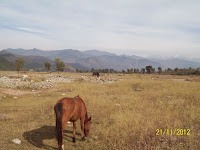Sarhad Ko Pranaam
After conquering western Ghats
right in the middle of rainy season, I was blessed with an opportunity to experience
the rugged terrain and inhospitable Himalayas in the beginning of winter
season. “Sarhad Ko Pranaam-A Salute to the Border and the People who protect it”
was going to be our theme for this unusual getaway. This was not just any
vacation. Little did I expect that this is going to be epic journey which gave
us deep insight about the life of people in remote villages alongside
India-Pakistan LOC.
It all started on late morning 21st
Nov 2012 from Poonch, a town 250KM north of Jammu. Our plan was to travel to
remote village of Jhulaas-Sulotri , about 20 km from Poonch and visit the LOC
and to know the lifestyle of people here. We reached the village at around 1 o’clock
in noon. This peaceful little village was nothing like what I thought it would be. Soon, the village made
us realize that our premonitions about a village which contained LOC was
nothing more than a fantasy.
This small village of around 2000
population had a breath-taking scenic beauty. Outlined by gigantic snow capped
peaks of Pir Panjal range, the village with scarce population density seemed
like a heaven on earth. River Pulatsya ran beside the village silently creating
a natural physical barrier between India and Pakistan. People carried out their
daily routine normally just like any
other typical village. The contrasting thing was that this village never
revealed a layman that it contained a LOC within.
A retired army veteran, Shourya
Chakra winner Hon. Capt. Balraj had volunteered to guide us through this
village. A visit to the army outpost gave us in-depth understanding the role of
armed forces in the life of a common man at border. An army personnel who
desired to keep his identity revealed us a great deal of information on what
has army acted towards the development of people around. Under “Sadbhavana” program army has built
schools, provided them with facilities, teachers, infrastructure, faculty, finance.
He also told us about locals’ dependency on army for their health and emergency
needs. He discussed briefly about the root causes of militancy – one of the
major problem in border villages. Illiteracy, ignorance , poverty were listed
by him.
 This event was followed by visit
to locals’ houses to get deep insight of lifestyle of people in border. The
dialect they spoke was known as Pahadi and was a mixture of Hindi, Punjabi and
Urdu. They provided us with plethora of information on the lifestyle of people
here.The climate here was very cold, with temperatures dropping to as low as 0
degree in winter Agriculture, mainly was their occupation with maize, paddy,
wheat. Interesting thing was they kept the produce for themselves. Unlike the typical
north Indian states, rice is staple food
here. They often ate it with spicy, delicious
and highly nutritious Rajma.
This event was followed by visit
to locals’ houses to get deep insight of lifestyle of people in border. The
dialect they spoke was known as Pahadi and was a mixture of Hindi, Punjabi and
Urdu. They provided us with plethora of information on the lifestyle of people
here.The climate here was very cold, with temperatures dropping to as low as 0
degree in winter Agriculture, mainly was their occupation with maize, paddy,
wheat. Interesting thing was they kept the produce for themselves. Unlike the typical
north Indian states, rice is staple food
here. They often ate it with spicy, delicious
and highly nutritious Rajma.
Youth preferred white collar jobs
like teaching, public service. Education available is of poor quality. Teachers
from outside Jammu were in great demand. Villages are scattered over
mountainous terrain as a result, children have to walk painstaking distance to
reach their school.
 |
| Behind the river, you can see the last Indian Army outpost guarding LOC. Beyond that, everything you see is Pak occupied Kashmir. Taken at the last village-Sulotri, Poonch,Jammu |
The day ended with a sumptous and
delicious dinner served at local residents’ home who had volunteered to accommodate
us for that night to help us achieve our cause of understanding the life of
people at border. Their hospitality was unmatched and their home was like a
home away from home. After a day long village survey, this was all we needed. The
next morning we built a human chain alongside border with our national flag
to signify the integrity of the boundary.
And thus an awe-inspiring journey ended.









Comments